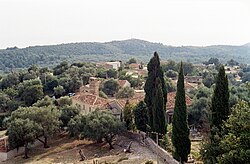This is an old revision of this page, as edited by Alexikoua (talk | contribs) at 21:01, 31 August 2010. The present address (URL) is a permanent link to this revision, which may differ significantly from the current revision.
Revision as of 21:01, 31 August 2010 by Alexikoua (talk | contribs)(diff) ← Previous revision | Latest revision (diff) | Newer revision → (diff) Not to be confused with Vouno. Village in Vlorë County, Albania| Vuno | |
|---|---|
| Village | |
 | |
| Country | |
| County | Vlorë County |
| District | Vlore District |
| Municipality | Himarë |
| Population | |
| • Total | 486 |
| Time zone | UTC+1 (CET) |
| • Summer (DST) | UTC+2 (CEST) |
Vuno (Template:Lang-el) is a village in the Albanian Riviera. It is located in the municipality of Himarë, in the District of Vlorë, Albania, along the road between Himarë and Dhërmi. The village is known for giving many World War II heroes and for showing a sympathy to the 1997 rebellion in Albania.
Name
It is said that because of the village location on the hills which ascend to about 300 metres, the name of the village derives from the Greek word Vouno (mountain in Greek). In a quirk of the local Greek dialect, the stress is on the penultimate syllable rather than the ultimate syllable as in standard modern Greek.
History
The village has many churches, but very curiously they are not operational as currently there are no priests in the village. A church that can be found in the Jali beach dates back to the 14th century and has a Venetian architecture. Two other churches, dedicated respectively to Saint Spyridon (1778) and to Saint Mary (1783) are still relatively well preserved. Local legend hails that the inhabitants of the village hail from the city of Shkoder and moved to Vuno, where they built the church of Saint Mary, which can be found at a salient point of the village, called Scutara. This church used to be a catholic one but subsequently it was converted into an Eastern Orthodox one.
The village gave many partisans to the National Liberation Army, during World War II. Four of them were post-mortem awarded with the People's Hero of Albania decoration. The most well known of them is Zaho Koka.
Vuno was reported as to have shown sympathy to the rebel outbreak in 1997 and like several other villages along the coast is reported to have a socialist and communist outlook.
Attractions
The beaches of Vuno together with the ones in Himarë represent the main tourist attraction of the municipality during the summer months. Jaliskari beach, between Vuno and Dhërmi, has became a well known summer resort attracting tourists all over the world.
Language
The inhabitants of Vuno use both Albanian and Greek, as in many villages of the region, although in the day-to-day language, mainly Albanian is used The Albanian local dialect is a southern Tosk one, more precisely a Labërisht sub-dialect. Labërisht itself is composed of non-unical language groups.
Vuno in Literature
Famous Albanian writer of Arbëreshë origin, Jeronim de Rada has placed the events of his Songs of Milosao (Template:Lang-sq) in Vuno. The songs were also published under the Italian name, Poesie albanesi del secolo XV. Canti di Milosao, figlio del despota di Scutari (Template:Lang-en.
Notable people
- Dhimitër Anagnosti, People's Artist of Albania, cineast, and former Minister of Culture, Youth and Sports;
- Spiro Çomora playwright
- Odhise Grillo, writer,
- Sofokli Lazri, counselor of Enver Hoxha and writer
- Odhise Kasneci, League of Prizren leader
- Zaho Koka, World War II hero and People's Hero of Albania
- Spiro Koleka, politician
- Anastas Kondo, writer
- Robert Ndrenika, actor (People's Artist of Albania)
- Athanasios Pipis (-1821), revolutionary of the Greek War of Independence.
References
- ^ Gregorič p. 46
- ^ Dede, Alqiviadh (15 shtator 2009). "Bregu i detit - Vunoi dhe Jali si perlat e tij". Gazeta Shqip (in Albanian). Retrieved 15 September 2009.
{{cite news}}: Check date values in:|date=(help) - Pettifer, James; Vickers, Miranda (2007). The Albanian question: reshaping the Balkans. I.B.Tauris. p. 32. ISBN 1860649742.
{{cite book}}: CS1 maint: multiple names: authors list (link) - Gregorič p. 45
- Gregorič, Nataša. "Contested Spaces and Negotiated Identities in Dhermi/Drimades of Himare/Himara area, Southern Albania" (PDF). University of Nova Gorica. p. 63. Retrieved 2010-08-15.
In their day-to-day conversations locals of Dhermi, Palase, and Himara mainly use a Greek dialect and partly a southern Albanian (Tosk) dialect, while the locals of Ilias, Vuno, Qeparo, Kudhes, and Pilur mainly speak the Albanian tosk dialect
- Gjinari, Jorgji (1989). Dialektet e gjuhës shqipe (in Albanian). Academy of Sciences of Albania, Institute of Linguistics. p. 57.
- Totoni, M (1971). Dialektologjia shqiptare I, Vëzhgime rreth të folmeve të Kurveleshit (Template:Lang-en) (in Albanian). p. 85.
Sources
- Gregorič, Nataša. "Contested Spaces and Negotiated Identities in Dhermi/Drimades of Himare/Himara area, Southern Albania" (PDF). University of Nova Gorica. Retrieved 2010-08-15.
| Albanian Riviera | ||
|---|---|---|
| Cities | ||
| Villages | ||
| National Parks | ||
| Castles | ||
| See also | ||